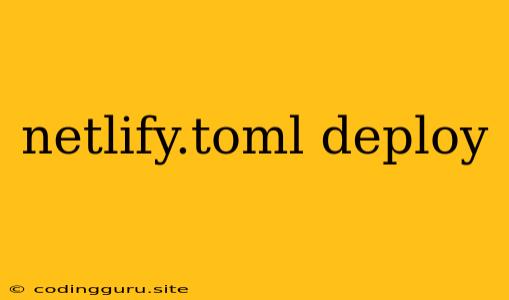Netlify.toml: Your Guide to Deploying Your Website with Ease
Netlify is a powerful platform for deploying static websites, providing a streamlined and automated workflow that simplifies the deployment process. Central to this process is the netlify.toml file, which acts as a configuration file for your Netlify project. This file lets you control various aspects of your website's deployment, including build settings, redirects, and custom domains.
What is netlify.toml?
The netlify.toml file is a configuration file written in the TOML (Tom's Obvious, Minimal Language) format, which is a simple, human-readable, and efficient way to define configurations. It allows you to customize how your website is built and deployed on Netlify, giving you granular control over the process.
Why Use netlify.toml?
While Netlify provides automatic deployment for many common frameworks and static site generators, using netlify.toml offers several advantages:
- Customization: You can tailor the deployment process to your specific needs, optimizing for performance, security, or functionality.
- Automation: Define your build steps, environment variables, and other configuration settings, automating the entire deployment process.
- Advanced Features: Control redirects, custom domain settings, and various other features directly within your project.
Essential netlify.toml Settings
Here's a breakdown of some key settings you can use in your netlify.toml file:
1. Build Settings:
build.command: This setting defines the command used to build your website. This is typically used for frameworks like React, Angular, or Vue.js.build.publish: Specifies the directory containing your built website files that Netlify should deploy.build.functions: For deploying serverless functions, this setting defines the directory containing your function code.
Example:
[build]
command = "npm run build"
publish = "dist"
2. Redirects:
[[redirects]]: Allows you to define redirects for your website. This can be useful for redirecting old URLs, setting up canonical URLs, or handling different versions of your website.
Example:
[[redirects]]
from = "/old-page"
to = "/new-page"
status = 301
3. Environment Variables:
env: Use this to set environment variables that are accessible to your website. This is useful for sensitive information or configuration options.
Example:
[env]
API_KEY = "your-api-key"
4. Custom Domains:
[[redirects]]: You can also use redirects to configure your custom domains.
Example:
[[redirects]]
from = "/*"
to = "https://www.example.com/*"
status = 200
5. Deploying a Static Website with netlify.toml
Here's a simple example of a netlify.toml file for a static website:
[build]
command = "npm run build"
publish = "build"
Steps to Deploy:
- Create
netlify.toml: Create anetlify.tomlfile in the root directory of your website. - Configure Settings: Define the necessary build settings, redirects, or other customizations.
- Push to Git: Commit and push your changes to your Git repository.
- Deploy to Netlify: Connect your project to Netlify.
- Netlify Automatically Deploys: Once you push changes to your Git repository, Netlify will automatically detect the changes, build your project, and deploy the new website.
6. Troubleshooting netlify.toml Issues:
- Verify Syntax: Ensure your
netlify.tomlfile is correctly formatted using the TOML syntax. - Check Documentation: Refer to the Netlify documentation for complete details on the available settings.
- Use Netlify CLI: Utilize the
netlifycommand-line interface to debug and test your configurations.
7. Examples of netlify.toml Use Cases:
- Deploying React Applications:
[build]
command = "npm run build"
publish = "build"
- Deploying Gatsby Websites:
[build]
command = "gatsby build"
publish = "public"
- Setting Up Redirects:
[[redirects]]
from = "/old-page"
to = "/new-page"
status = 301
[[redirects]]
from = "/blog/*"
to = "/posts/*"
status = 301
- Deploying Serverless Functions:
[build]
command = "npm run build"
publish = "build"
functions = "functions"
Conclusion:
The netlify.toml file is a powerful tool for managing your website deployments on Netlify. It allows you to customize, automate, and optimize your deployment workflow, making it easier and more efficient to deploy your websites and applications. By understanding and utilizing the netlify.toml file, you can leverage the full capabilities of the Netlify platform to create a smooth and streamlined development experience.
